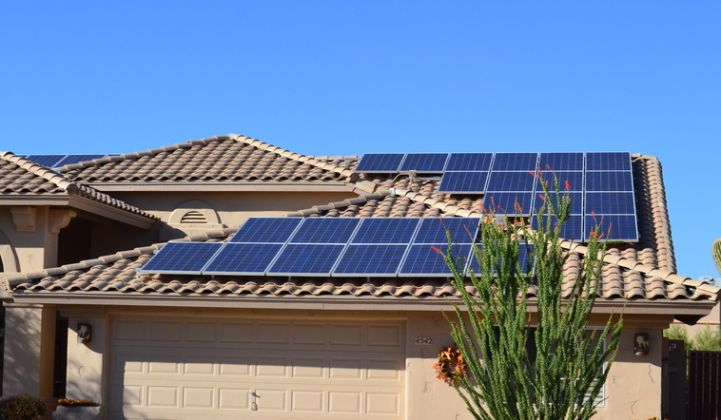Arizona Public Service, electric industry representatives and solar advocates have reached a rate design settlement that could help bring an end to years of fierce policy debates in Arizona.
"This settlement was a compromise with a lot of different parties involved and a lot of different interests recognized," Stefanie Layton, director of revenue requirements at APS, told GTM. "And it’s an agreement that’s a win for customers."
"The term sheet provides an opportunity for continued investment in smarter and cleaner energy infrastructure," she added. "It gives our customers more choices and control through new rate options and allows for continued solar leadership in Arizona.”
In a key development, the settlement plan dismisses APS' original request to implement mandatory demand rates for all residential and small commercial customers. Instead, it gives all new distributed solar customers the option to take a demand-based rate or a time-of-use (TOU) rate. It also allows non-solar customers to adopt a demand or TOU rate, but does not require that they select an alternative. However, after May 1, 2018, all new APS customers will move to a time-varying rate by default.
If the settlement is approved by the Arizona Corporation Commission (ACC), new solar customers would also see a change in their self-consumption and grid export rates. The settlement would set the self-consumption offset rate around 12 cents per kilowatt-hour, which includes a grid access fee that APS solar customers must pay. The new export rate, based on the ACC's newly adopted resource proxy model, would be 12.9 cents per kilowatt-hour. Arizona solar customers are currently compensated for their excess solar generation at rates between 13 and 14 cents per kilowatt-hour.
The "Resource Comparison Proxy" (RCP) methodology referred to in the settlement was approved in December as part of a yearlong value-of-solar proceeding (E-00000J-14-0023). Going forward, solar export rates will either be determined by the RCP, or by an avoided-cost methodology that uses five-year forecasting to evaluate the costs and values of energy, capacity and other services delivered to the grid from distributed generation. Export rates are to be reevaluated on an annual basis.
While the export rate is subject to change, the proposed settlement released today keeps compensation distributed solar customers roughly on par for the near term. And while new rooftop solar customers are required to adopt one of four new TOU or demand-based rate options, solar stakeholders indicated that these options are workable. Significantly, the agreement also guarantees that existing rooftop solar customers will have 20 years of full retail-rate net metering on their current utility rate plan.
According to the Arizona Solar Energy Industries Association (AriSEIA), the settlement, if adopted, would shrink Arizona's solar industry, but allow the market to remain intact.
"The future of Arizona's solar industry was very much on the line in this case, and while this settlement doesn't help Arizona solar grow, it allows solar to remain a viable option for some Arizonans," said Brandon Chesshire of Sun Harvest Solar, board president of AriSEIA, in a statement.
Anne Hoskins, chief policy officer at Sunrun, praised the collaborative nature of the agreement and underscored Sunrun's commitment to serving the Arizona market. But she also stated that the settlement "does not fully recognize the multitude of benefits that rooftop solar brings to all Arizonans."
“As recent research confirms, rooftop solar power can deliver benefits above the retail rate of electricity and provides opportunities to all customers through grid modernization, local jobs, and affordable clean energy choices," Hoskins said.
Sunrun and other solar stakeholders will continue to make their case that Arizona regulators should account for the full spectrum of benefits distributed solar provides during the annual export rate review process. Alex McDonough, Sunrun's new vice president of policy, added that his company does not view the Arizona outcome as a precedent for how the industry should value solar, "but we do support having collaborative discussion about how to make policies workable for solar and provide customers choice."
The decision to forge a settlement agreement is widely viewed as the preferable alternative to months of legal debates over APS' proposed rate plan. Thirty of the 40 parties involved in the case signed on to the agreement, including ACC staff and the Residential Utility Consumer Office. Signatories to the settlement agreed to refrain from undermining it through ballot initiatives, legislation or advocacy at the ACC.
Overall, the settlement proposal will increase the average residential electricity customer's monthly bill by $6, but that's down from the $11 increase APS initially requested. The deal also includes other customer benefits, including a $15 million refund in unspent cash earmarked for efficiency projects, an additional $13 million to assist low-income customers, and a rate-hike freeze until June 1, 2019.
APS will also be permitted to spend $10 million to $15 million per year to install solar for low-income customers and at multi-family units. The utility also agreed to place a moratorium on new self-build generation prior to January 1, 2022, excluding distributed energy projects, renewable energy generation, microgrids and upgrades to existing infrastructure.
The settlement is still subject to debate and a vote by Arizona's five elected utility commissioners.



